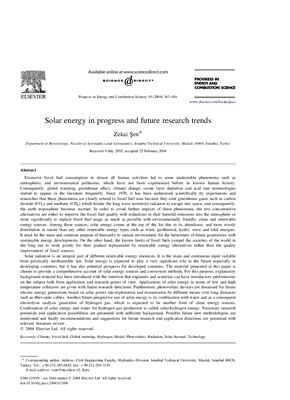На английском языке. Обзорная статья опубликована в ж. Progress in
Energy and Combustion Science, 2004, V. 30(4), P. 367–416.
Abstract
Extensive fossil fuel consumption in almost all human activities led to some undesirable phenomena such as atmospheric and environmental pollutions, which have not been experienced before in known human history. Consequently, global warming, greenhouse affect, climate change, ozone layer depletion and acid rain terminologies started to appear in the literature frequently. Since 1970, it has been understood scientifically by experiments and researches that these phenomena are closely related to fossil fuel uses because they emit greenhouse gases such as carbon dioxide (CO2) and methane (CH4) which hinder the long wave terrestrial radiation to escape into space, and consequently, the earth troposphere becomes warmer. In order to avoid further impacts of these phenomena, the two concentrative alteatives are either to improve the fossil fuel quality with reductions in their harmful emissions into the atmosphere or more significantly to replace fossil fuel usage as much as possible with environmentally friendly, clean and renewable energy sources. Among these sources, solar energy comes at the top of the list due to its abundance, and more evenly distribution in nature than any other renewable energy types such as wind, geothermal, hydro, wave and tidal energies. It must be the main and common purpose of humanity to sustain environment for the betterment of future generations with sustainable energy developments. On the other hand, the known limits of fossil fuels compel the societies of the world in the long run to work jointly for their gradual replacement by renewable energy alteatives rather than the quality improvement of fossil sources.
Solar radiation is an integral part of different renewable energy resources. It is the main and continuous input variable from practically inexhaustible sun. Solar energy is expected to play a very significant role in the future especially in developing countries, but it has also potential prospects for developed countries. The material presented in this paper is chosen to provide a comprehensive account of solar energy sources and conversion methods. For this purpose, explanatory background material has been introduced with the intention that engineers and scientists can have introductory preliminaries on the subject both from application and research points of view. Applications of solar energy in terms of low and high temperature collectors are given with future research directions. Furthermore, photovoltaic devices are discussed for future electric energy generations based on solar power site-exploitation and transmission by different means over long distances such as fiber-optic cables. Another future perspective use of solar energy is its combination with water and as a consequent electrolysis analysis generation of hydrogen gas, which is expected to be another form of clean energy sources. Combination of solar energy and water for hydrogen gas production is called solar-hydrogen energy. Necessary research potentials and application possibilities are presented with sufficient background. Possible future new methodologies are mentioned and finally recommendations and suggestions for future research and application directions are presented with relevant literature review.
Abstract
Extensive fossil fuel consumption in almost all human activities led to some undesirable phenomena such as atmospheric and environmental pollutions, which have not been experienced before in known human history. Consequently, global warming, greenhouse affect, climate change, ozone layer depletion and acid rain terminologies started to appear in the literature frequently. Since 1970, it has been understood scientifically by experiments and researches that these phenomena are closely related to fossil fuel uses because they emit greenhouse gases such as carbon dioxide (CO2) and methane (CH4) which hinder the long wave terrestrial radiation to escape into space, and consequently, the earth troposphere becomes warmer. In order to avoid further impacts of these phenomena, the two concentrative alteatives are either to improve the fossil fuel quality with reductions in their harmful emissions into the atmosphere or more significantly to replace fossil fuel usage as much as possible with environmentally friendly, clean and renewable energy sources. Among these sources, solar energy comes at the top of the list due to its abundance, and more evenly distribution in nature than any other renewable energy types such as wind, geothermal, hydro, wave and tidal energies. It must be the main and common purpose of humanity to sustain environment for the betterment of future generations with sustainable energy developments. On the other hand, the known limits of fossil fuels compel the societies of the world in the long run to work jointly for their gradual replacement by renewable energy alteatives rather than the quality improvement of fossil sources.
Solar radiation is an integral part of different renewable energy resources. It is the main and continuous input variable from practically inexhaustible sun. Solar energy is expected to play a very significant role in the future especially in developing countries, but it has also potential prospects for developed countries. The material presented in this paper is chosen to provide a comprehensive account of solar energy sources and conversion methods. For this purpose, explanatory background material has been introduced with the intention that engineers and scientists can have introductory preliminaries on the subject both from application and research points of view. Applications of solar energy in terms of low and high temperature collectors are given with future research directions. Furthermore, photovoltaic devices are discussed for future electric energy generations based on solar power site-exploitation and transmission by different means over long distances such as fiber-optic cables. Another future perspective use of solar energy is its combination with water and as a consequent electrolysis analysis generation of hydrogen gas, which is expected to be another form of clean energy sources. Combination of solar energy and water for hydrogen gas production is called solar-hydrogen energy. Necessary research potentials and application possibilities are presented with sufficient background. Possible future new methodologies are mentioned and finally recommendations and suggestions for future research and application directions are presented with relevant literature review.

